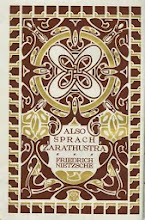Emile Durkheim's Conscience Collective
So I'm reading The Elementary Forms of Religious Life by Emile Durkheim and I thought that this little selection from the Translator's Introduction was especially thought provoking and revealing, so I will just quote it in it's entirety. Oh, by the way, the Translator is a women named Karen E. Fields and a definition of totemism is in order before we get underway, as the ritual being explained is a totemic ritual, so here we go.
A totem is any natural or supernatural being or animal which watches over or assists a group of people, such as a family, clan or tribe
and
Totemism (derived from the root -oode in the Ojibwe language, which referred to something kinship-related) is a religious belief that is frequently associated with shamanistic religions. The totem is usually an animal or other naturalistic figure that spiritually represents a group of related people such as a clan.
Here is the quote in its entirety:
Durkheim's account of rites is meant to seize the idea of force at its 'birth,' as he says. He found the birth of that idea in rites, at moments of collective effervescence, when human beings feel themselves transformed, and are in fact transformed, through ritual doing. A force experience as external to each individual is the agent of that transformation, but the force itself is created by the fact of assembling and temporarily living a collective life that transports individuals beyond themselves. Those moments he conveys in a set piece drawn from ethnographic description.
Durkheim's set piece opens with the practical occupations of life suspended, the validity of ordinary rules adjourned, people dressed and painted to resemble one another and the animal or plant by which they name their shared identity, the objects around them 'uniformed' in the same way, the whole taking place under a night sky, the scene dotted with firelight, and frenzy-a collective effervescence. Swept away, the participants experience a force external to them, which seems to be moving them, and by which their very nature is transformed. They experience themselves as grander than at ordinary times; they do things they would not do at other times; they feel, and at that moment really are, joined with each other and with the totemic being. They come to experience themselves as sharing one and the same essence-with the totemic animal, with its representation, and with each other. In addition, since a symbolic representation of the totemic being stands at the center of things, the real power generated in the assembly comes to be thought of as residing in the totemic object itself. Symbols of the totemic object extend the effects of the effervescence into life after the assembly is dispersed. Seen on objects, and sometimes on bodies, totemic representations of various kinds will fill the role of what would be called today a secondary stimulus-a reminder that reactivates the initial feelings, although more dimly. Since the transformation cannot be done once and for all and fades despite the symbolic reminders, it must periodically be redone-hence, the cyclically repetitive performance of rites.
Through real experience, then, participants come to ascribe power to sacred objects, that power having nothing to do with the physical characteristics o those objects. It is also through real experience that they arrive at the concepts of force, but the real experience they have is that human beings assembled-or to use Durkheim's abstract formulation, that of society's 'concentrating' or 'pulling itself together' and thus becoming a unity in the real. This depiction will no doubt seem contrived and mechanical at first gland and on that account may tempt discounting, until the historical memory it activates in us brings us to similar events that we ourselves know operated mechanically-uniformed, firelit, nighttime effervescences of the Nazis or the Ku Klux Klan, with individuals led to impute to themselves shared inborn essences and fabulous collective identities, with symbolic reminders shaping everyday life afterward, and with individual doubt in large part not requiring physical violence to be overcome. This mechanism itself is neither good nor evil [Think of mega-churches, concerts, a home game at the Big House]. If Durkheim is right that is universal, then we should expect to find it, and do find it, from tattooed street gangs to the Salvation Army, from the habits of the convent to those of the exclusive club.
I hope you got as much out of this as I did.
Marie said:
The totem animal I'm thinking of is a rat. Like when the Turtles were separated from Splinter and then sat around the fire at April's old farm house and then Splinter appeared to them all in the fire... "the whole taking place under a night sky, the scene dotted with firelight, and frenzy-a collective effervescence. Swept away, the participants experience a force external to them, which seems to be moving them, and by which their very nature is transformed." Not unlike the ooze that transformed them...


<< Home